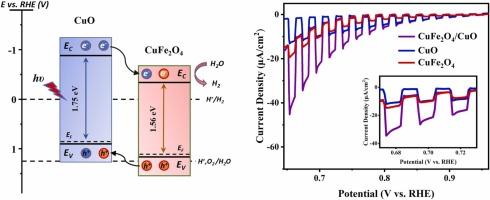CuFe2O4/CuO异质结光电阴极的原位构建改进太阳能水分解
IF 6.3
2区 材料科学
Q2 CHEMISTRY, PHYSICAL
引用次数: 0
摘要
由于CuFe2O4具有合适的光学带隙和可见光响应特性,被认为是一种有前景的光电阴极候选材料。但其载流子输运能力差,严重制约了其光催化性能。本研究首次采用喷雾热解法原位构建CuFe2O4/CuO异质结光电极,显著提高了其光电催化性能。系统地分析和评价了CuFe2O4、CuO和CuFe2O4/CuO异质结薄膜的关键物理和光物理性质。实验结果表明,优化后的CuFe2O4/CuO在0.7 V / RHE下的净光电流密度为17 μA/cm2,比原始CuFe2O4提高2.6倍。这表明异质结有效地加速了光生电荷的分离,提高了催化反应效率。进一步比较CuFe2O4/CuO和CuO/CuFe2O4双层异质结发现,由于界面带错配,CuFe2O4双层异质结的暗电流增加,而光电流没有明显增强,证实了原位异质结生长在优化界面电荷输运中的关键作用。该研究为利用能带工程构建金属氧化物异质结构光电极提供了新的思路。本文章由计算机程序翻译,如有差异,请以英文原文为准。

In situ construction of CuFe2O4/CuO heterojunction photocathode for improved solar water splitting
CuFe2O4 is considered to be a prospective photocathode candidate due to its suitable optical bandgap and visible light response characteristics. However, its poor charge carrier transport capability severely restricts the photocatalytic performance. In this study, a CuFe2O4/CuO heterojunction photoelectrode was in situ constructed via spray pyrolysis for the first time, significantly enhancing photoelectrocatalytic performance. The key physical and photophysical properties of CuFe2O4, CuO, and CuFe2O4/CuO heterojunction thin films were systematically analyzed and evaluated. Experimental results demonstrate that the optimized CuFe2O4/CuO attains a net photocurrent density of 17 μA/cm2 under 0.7 V vs. RHE, exhibiting a 2.6-fold enhancement over pristine CuFe2O4. This indicates that the heterojunction effectively accelerates the separation of photogenerated charges and boosts catalytic reaction efficiency. Further comparison between CuFe2O4/CuO and CuO/CuFe2O4 bilayer heterojunctions reveals that the latter exhibits increased dark current and no significant photocurrent enhancement due to interfacial band mismatch, confirming the critical role of in situ heterojunction growth in optimizing interfacial charge transport. This study offers novel perspectives on constructing metal oxide heterostructure photoelectrodes through band engineering.
求助全文
通过发布文献求助,成功后即可免费获取论文全文。
去求助
来源期刊

Journal of Alloys and Compounds
工程技术-材料科学:综合
CiteScore
11.10
自引率
14.50%
发文量
5146
审稿时长
67 days
期刊介绍:
The Journal of Alloys and Compounds is intended to serve as an international medium for the publication of work on solid materials comprising compounds as well as alloys. Its great strength lies in the diversity of discipline which it encompasses, drawing together results from materials science, solid-state chemistry and physics.
 求助内容:
求助内容: 应助结果提醒方式:
应助结果提醒方式:


